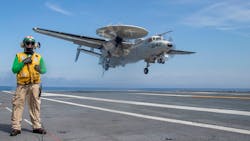Northrop Grumman to provide displays, mission computers, and stress stations for Navy E-2D aircraft avionics
PATUXENT RIVER NAS, Md. – Avionics engineers at Northrop Grumman Corp. will provide new computers and displays for the U.S. Navy E-3D Hawkeye carrier-based radar surveillance aircraft under terms of a $13.1 million order announced just before Christmas.
Officials of the Naval Air Systems Command at Patuxent River Naval Air Station, Md., are asking the Northrop Grumman Aeronautics Systems segment in Melbourne, Fla., to provide 39 avionics flight mission computers, 10 control display units, and one environmental stress screening station for the E-2D aircraft.
Compared with its E-2C predecessor, the E-2D has a new mission computer and tactical workstations. It also has a redesigned radar with mechanical and electronic scanning capabilities; glass cockpit; advanced identification friend or foe (IFF) system; electronic support measures enhancements; and a modernized communications and data link suite.
The control display unit (CDU) for the E-2D consolidates control of the aircraft's flight-management functions and communications, navigation, weapons management and defensive aids equipment into one unit.
The E-2D's environmental stress screening station helps monitor exposure of the plane's newly manufactured or repaired avionics components to stresses like thermal cycling and vibration to reveal defects. Electronic components that survive environmental screening are expected to have higher reliability than similar unscreened components.
The Navy Northrop Grumman E-2D is a tactical airborne early warning (AEW) aircraft designed to operate from aircraft carriers. The twin-engine turboprop aircraft has a distinctive antenna, and provides the carrier battle group with wide-area radar surveillance for enemy monitoring and combat air traffic control.
Its large saucer-like radar antenna mounted to the top of the aircraft, as well as other advanced avionics, enables it to detect hostile aircraft and missiles at extremely long ranges and vector Navy aircraft to intercept.
Northrop Grumman officials call the E-2D reconnaissance aircraft a "digital quarterback" to sweep ahead of Navy aircraft carrier strike groups, manage missions, and keep U.S. network-centric carrier battle groups out of harm's way. The aircraft provides battle management, theater air and missile defense, and multi-sensor fusion capabilities.
The plane is nearly 58 feet long, has an 80-foot wingspan, can fly faster than 300 knots, and can fly to altitudes as high as 37.000 feet. It carriers a crew of five: two pilots and three mission systems operators. The co-pilot also can act as a fourth mission systems operator.
For more information contact Northrop Grumman Aeronautics Systems online at www.northropgrumman.com, or Naval Air Systems Command at www.navair.navy.mil.
About the Author
John Keller
Editor-in-Chief
John Keller is the Editor-in-Chief, Military & Aerospace Electronics Magazine--provides extensive coverage and analysis of enabling electronics and optoelectronic technologies in military, space and commercial aviation applications. John has been a member of the Military & Aerospace Electronics staff since 1989 and chief editor since 1995.
